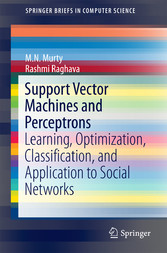Suchen und Finden
Mehr zum Inhalt

Support Vector Machines and Perceptrons - Learning, Optimization, Classification, and Application to Social Networks
Preface
6
Overview
6
Audience
7
Organization
7
Contents
9
Acronyms
13
1 Introduction
14
1.1 Terminology
14
1.1.1 What Is a Pattern?
14
1.1.2 Why Pattern Representation?
15
1.1.3 What Is Pattern Representation?
15
1.1.4 How to Represent Patterns?
15
1.1.5 Why Represent Patterns as Vectors?
15
1.1.6 Notation
16
1.2 Proximity Function 1--4
16
1.2.1 Distance Function
16
1.2.2 Similarity Function
17
1.2.3 Relation Between Dot Product and Cosine Similarity
18
1.3 Classification 2--4
19
1.3.1 Class
19
1.3.2 Representation of a Class
19
1.3.3 Choice of G(X)
20
1.4 Classifiers
20
1.4.1 Nearest Neighbor Classifier (NNC)
20
1.4.2 K-Nearest Neighbor Classifier (KNNC)
20
1.4.3 Minimum-Distance Classifier (MDC)
21
1.4.4 Minimum Mahalanobis Distance Classifier
22
1.4.5 Decision Tree Classifier: (DTC)
23
1.4.6 Classification Based on a Linear Discriminant Function
25
1.4.7 Nonlinear Discriminant Function
25
1.4.8 Naïve Bayes Classifier: (NBC)
26
1.5 Summary
27
References
27
2 Linear Discriminant Function
28
2.1 Introduction
28
2.1.1 Associated Terms 1--3
28
2.2 Linear Classifier [2--4]
30
2.3 Linear Discriminant Function 2
32
2.3.1 Decision Boundary
32
2.3.2 Negative Half Space
32
2.3.3 Positive Half Space
32
2.3.4 Linear Separability
33
2.3.5 Linear Classification Based on a Linear Discriminant Function
33
2.4 Example Linear Classifiers 2
36
2.4.1 Minimum-Distance Classifier (MDC)
36
2.4.2 Naïve Bayes Classifier (NBC)
36
2.4.3 Nonlinear Discriminant Function
37
References
38
3 Perceptron
39
3.1 Introduction
39
3.2 Perceptron Learning Algorithm [1]
40
3.2.1 Learning Boolean Functions
40
3.2.2 W Is Not Unique
42
3.2.3 Why Should the Learning Algorithm Work?
42
3.2.4 Convergence of the Algorithm
43
3.3 Perceptron Optimization
44
3.3.1 Incremental Rule
45
3.3.2 Nonlinearly Separable Case
45
3.4 Classification Based on Perceptrons 2
46
3.4.1 Order of the Perceptron
47
3.4.2 Permutation Invariance
49
3.4.3 Incremental Computation
49
3.5 Experimental Results
50
3.6 Summary
51
References
52
4 Linear Support Vector Machines
53
4.1 Introduction
53
4.1.1 Similarity with Perceptron
53
4.1.2 Differences Between Perceptron and SVM
54
4.1.3 Important Properties of SVM 1--5
54
4.2 Linear SVM 1, 5
55
4.2.1 Linear Separability
55
4.2.2 Margin
56
4.2.3 Maximum Margin
58
4.2.4 An Example
59
4.3 Dual Problem
61
4.3.1 An Example
62
4.4 Multiclass Problems 2
63
4.5 Experimental Results
64
4.5.1 Results on Multiclass Classification
64
4.6 Summary
66
References
68
5 Kernel-Based SVM
69
5.1 Introduction
69
5.1.1 What Happens if the Data Is Not Linearly Separable? 2--4,6
69
5.1.2 Error in Classification
70
5.2 Soft Margin Formulation 2
71
5.2.1 The Solution
71
5.2.2 Computing b
72
5.2.3 Difference Between the Soft and Hard Margin Formulations
72
5.3 Similarity Between SVM and Perceptron
72
5.4 Nonlinear Decision Boundary 1--6
74
5.4.1 Why Transformed Space?
75
5.4.2 Kernel Trick
75
5.4.3 An Example
76
5.4.4 Example Kernel Functions
76
5.5 Success of SVM 2--5
76
5.6 Experimental Results
77
5.6.1 Iris Versicolour and Iris Virginica
77
5.6.2 Handwritten Digit Classification
78
5.6.3 Multiclass Classification with Varying Values of the Parameter C
78
5.7 Summary
79
References
79
6 Application to Social Networks
80
6.1 Introduction
80
6.1.1 What Is a Network?
80
6.1.2 How Do We Represent It?
80
6.2 What Is a Social Network? 1--4
83
6.2.1 Citation Networks
84
6.2.2 Coauthor Networks
84
6.2.3 Customer Networks
84
6.2.4 Homogeneous and Heterogeneous Networks
84
6.3 Important Properties of Social Networks 4
85
6.4 Characterization of Communities 2--3
86
6.4.1 What Is a Community?
86
6.4.2 Clustering Coefficient of a Subgraph
87
6.5 Link Prediction 1--4
88
6.5.1 Similarity Between a Pair of Nodes
89
6.6 Similarity Functions 1--4
90
6.6.1 Example
91
6.6.2 Global Similarity
92
6.6.3 Link Prediction based on Supervised Learning
93
6.7 Summary
94
References
94
7 Conclusion
95
Glossary
98
Index
99
Alle Preise verstehen sich inklusive der gesetzlichen MwSt.







